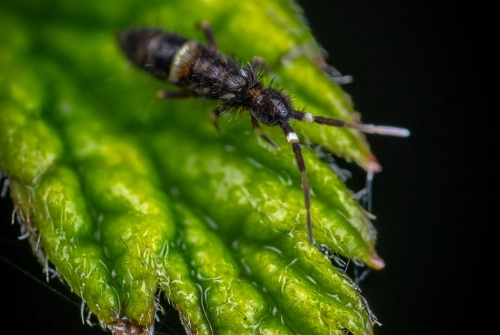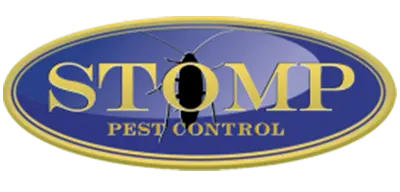Springtails are abundant in North Carolina as they enjoy sunny areas that get plenty of moisture. Springtails are typically less than 6 millimeters in length and have a furcula, a forked tail-like appendage tucked beneath their abdomen. When threatened or disturbed, they can release this furcula to catapult themselves into the air, effectively escaping predators or relocating. This jumping mechanism is where their common name, “springtails,” originates from.
Springtails in house environments can quickly become a nuisance, even though these insects aren’t harmful or able to sting. If you’ve noticed them in your home or yard, follow this article as the pest technicians at Stomp Pest Control answer common questions about springtails and help you learn how to get rid of them.
Table of Contents
What are Springtails?
Springtails are a group of small, soil-dwelling arthropods found in sunny habitats around the world, including forests, grasslands, and agricultural fields. Their jumping behavior is similar to fleas — they move around quickly and hop from place to place. Unless it’s a bright, sunny day, you typically won’t see them in the wintertime. But make no mistake — they can survive the winter months and have been seen jumping around on the snow on sunny days.
What do Springtails Look Like?
Measuring about 1/16” long, springtails can be difficult to see because of their small size. Their colors range from white, grey, brown, green, and even metallic hues. Their bodies are segmented and can be either elongated and slender or compact and rounded, depending on the species. As previously mentioned, they have a furcula that folds beneath their abdomen when they aren’t jumping around.

Their heads have an antennae, which varies in length and is used for sensing their surroundings. They have compound eyes, although some species may be blind, particularly those adapted to life in soil or caves. The surface of their bodies can appear smooth or covered with scales or hairs, which sometimes give them a shiny appearance.
Where are Springtails Found?
While springtails are small, they are mighty. They can withstand all types of climates and can be found throughout the United States. Springtails are often found living in damp soil, fungi, lead mold, and decaying logs. You can also find springtails around pools with nearby vegetation, air conditioning components, and other moist areas.
If your home has recently encountered a leak, assess for springtails in the area since they are attracted to moist spots. Springtails in house environments can be found in bathrooms, kitchens, basements and anywhere else there are humidity issues.
Are Springtails Dangerous?
Springtails are not dangerous to humans, pets, or the structural integrity of buildings. They are benign creatures that play a vital role in the ecosystem, primarily involved in the decomposition process and the nutrient cycle in soil. However, springtails in house environments can be a nuisance and you’ll want to eradicate them before they take over.
Springtails in house environments are searching for moisture during dry periods, but they are not one of the stinging insects nor do they cause structural damage.
The Best Ways to Get Rid of Springtails in House
Getting rid of springtails involves reducing their preferred habitat conditions, particularly by controlling moisture and humidity, both indoors and around your home. Here are some practical steps to manage and prevent springtail infestations:
Indoor Springtail Control
Reduce Humidity
Controlling springtails in house areas starts with controlling excess moisture. Use dehumidifiers, air conditioners, and fans to lower indoor humidity levels. Ventilate areas prone to moisture, like bathrooms and kitchens, and fix any leaks in plumbing fixtures.
Fix Leaks & Excess Water
Fix leaks and eliminate standing water in basements, crawl spaces, and around the foundation. Ensure gutters and downspouts are directing water away from your home’s foundation.
Vacuum Regularly
Vacuuming can help remove springtails from indoor spaces, especially when they are found in large numbers.
Seal Entry Points
Caulk and seal cracks and crevices around windows, doors, and the foundation to prevent springtails from finding their way inside your home.
Outdoor Springtail Control
Improve Drainage
Ensure the soil around your home is encouraged to drain downhill so it does not retain excessive moisture. Use landscaping to divert water away from your home’s foundation.
Reduce Excessive Mulch and Organic Debris
Springtails thrive in moist, organic matter. Keep mulch, leaf litter, and other organic debris away from your home’s foundation to reduce habitat for springtails.
Adjust Watering Practices
Overwatering lawns and gardens can create favorable conditions for springtails. Make sure you don’t leave your garden hose on too long and have a place where your plants are encouraged to soak up moisture.
Pest Control
Since springtails are attracted to damp places, it’s important to assess your home for leaks and correct damp areas when possible to encourage springtails to move on. But if they have found their way into your home and you can’t seem to get rid of them, a pest control professional, such as Stomp Pest Control, can offer corrective action with appropriate treatment. Our affordable pest control focuses on creating undesirable conditions for springtails so they won’t continue to take over your home. We use pet and child-friendly solutions so your family can go about the house like normal without worrying about getting sick from our treatments.
Remember, springtails are an indicator of high moisture levels, so addressing the root cause of the moisture problem is key to long-term control. Reducing favorable conditions for springtails not only helps to manage their populations but also contributes to a healthier living environment by mitigating mold growth and other moisture-related issues.
FAQ About Springtails
When are springtails active?
Springtails are more active on cooler days during the warmer months and on sunny days during the winter. Since springtails need moisture to thrive, they are typically not very active on hot, dry days. They are typically most active during the afternoon and early evening and when the temperatures are cooler.
What do springtails eat?
Springtails eat small organisms and organic matter. Mold spores and fungi are their most common food source. They are also known to consume bacteria from decaying organic matter.
Is it common to find springtails in your home?
Springtails in house environments are common when moisture (i.e. humidity and leaks) are present. In addition to moisture, springtails are attracted to light, so they will enter homes through doors and gaps in window seals.
Are there any benefits of springtails?
If you see springtails in your yard, it’s a sign that your soil is healthy! Springtails play a crucial role in the decomposition process by breaking down organic matter such as dead leaves, wood, and other plant debris. This activity helps in recycling nutrients, enriching the soil, and maintaining its fertility. So, unless you’ve seen springtails in home spaces, they’re not just harmless outdoors but they’re beneficial.
What’s the best way to prevent a springtail infestation?
The best way to prevent a springtail infestation is to limit excess moisture. Keep gutters clear and fix any drainage issues around the home. Dispose of decaying logs and plants as well as piles of debris.
If you have firewood outside your home, stack it away from walls and on an elevated surface instead of directly on the ground.
Seal areas around your bathtub or shower, sinks, and doors to discourage springtails from coming inside.
Contact Stomp Pest Control to Manage Springtails in Your Home
If you’ve seen springtails in your home, the pest control professionals at Stomp Pest Control can help. We manage springtails with a focus on balancing their populations by creating unfavorable conditions for overpopulation. We serve the Triangle including Raleigh, Garner, Wake Forest, Durham, and more.
Contact us at (919) 231-3292 or fill out the form below to learn more about our pest control services.

